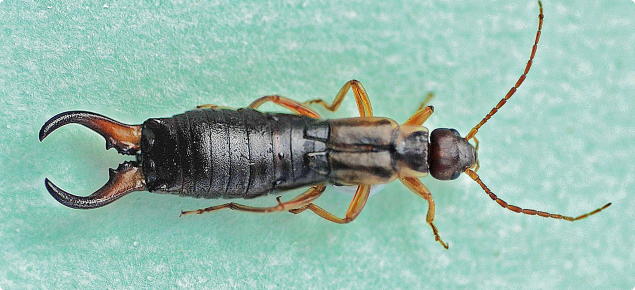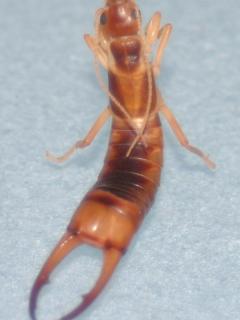Description
European earwigs
- Adult European earwigs range from 12-24mm long.
- European earwigs have uniform brown bodies that are smooth and shiny with light brown/ yellow legs, pincers (also called forceps) and 'shoulders'.
- These earwigs have a flattened, elongated body with a reddish brown head and slender, beaded antennae.
- Pincers of male earwigs are long and curved while those of females are almost straight.
- Young earwigs, also called nymphs, look similar to adults but are smaller, paler and do not have wings.
Native earwigs
Native earwigs are widespread and feed mainly on leaf litter and other organic material and are not known to damage crops.
They are often solitary and will not be seen in the high numbers usually associated with pest populations of European earwigs.
There are two species commonly confused with European earwigs:
Carcinophora occidentalis (no common name)
- Have reddish brown foreparts and legs with a darker abdomen and pincers.
Labidura truncata (common brown earwig)
- Has similar colouring to European earwig.
- Can be distinguished from European earwig by presence of orange triangle behind the head on the wing case.
Habits
Earwigs are nocturnal and during the day shelter on trees under bark or on the ground under stubble, mulch, rocks or logs.
European earwigs tend to exist in large groups congregating together. They will generally be more abundant than native earwigs which are usually found as single insects.
European earwigs feed at night on a wide range of food types such as organic matter, fruits, ornamental plants, vegetables, flowers, seeds and live and dead insects - including other earwigs and soft bodied insects such as aphids and eggs of insects such as lightbrown apple moth.
European earwig can be considered a beneficial agent with respect to controlling woolly aphid in apple orchards.
This adaptable insect is able to survive under a variety of environmental conditions.
Lifecycle
The length of the lifecycle depends on temperature. At 25°C, the development from egg to adult takes around ten weeks, but at 15°C it takes up to five weeks longer.
Adult females lay batches of 20-80 white oval eggs in burrows in the topsoil which hatch in 2-3 weeks. There are several nymphal instars (immature growth stages between moults). Female earwigs display maternal care, remaining in the burrow protecting the eggs and nymphs. Females guard the early instar nymphs initially, but after a couple of moults the young must fend for themselves or risk being cannibalised.
There are two generations per year. One breeding cycle occurs in late winter/early spring and a second in summer.
Damage
Broadacre crops
European earwigs have been known to damage cereal, legume and oilseed crops.
Intensive cropping and stubble retention practices suit this species. Crop residues on the soil surface increase their survival and breeding, allowing large populations to build up during autumn and early winter and damage crops sown into the stubble.
Shredded leaf tips, or jagged holes in the leaves is typical of earwig damage. In severe situations European earwigs can completely defoliate young seedlings leaving only stems or bare ground in patches.
Vegetable and fruit crops
European earwigs have rarely been found to damage leafy green vegetables. The damage is easily confused with damage from slugs or snails as the leaves have a shredded, jagged appearance.
Damage in commercial fruit crops has predominantly been reported in cherries. Even though the leaves can be damaged, most economic loss has occurred from feeding damage to fruit. The fruit can be in various stages of development and the damage can be confused with feeding by birds or slugs and snails.
Grapes and grapevines
In vineyards, leaf damage is obvious in spring when new growth is appearing. This feeding does not affect fruit yield or quality as subsequent vegetation growth is sufficient to maintain vine health.
Earwigs have been reported feeding on developing grapes and close monitoring is required to avoid direct fruit loss.
The most likely problem with European earwigs in vineyards is their presence in harvested berries and the risk of tainting wine.
Monitoring
The earlier European earwigs are detected, the earlier control measures can be applied to either control or suppress the population.
The following monitoring techniques can be used:
Create refuges
European earwigs seek shelter during the day. Checking under boards placed on the ground or using corrugated cardboard rolls or bands on trunks of orchard trees or grapevines is an easy way to detect European earwigs.
Check at night
The earwigs tend to feed at night and if numbers are high they can be easily seen on crop edges, in orchard trees and grape vines.
Thresholds
It takes more than one season for European earwigs to build up in numbers. Consider applying control measures if European earwigs are easily found prior to planting in broadacre or vegetable crops or bud burst in fruit crops.
The number of European earwigs per square metre can be difficult to estimate. When earwigs are disturbed they move rapidly and it is easy to under estimate numbers especially in cropped paddocks.
The first thing that is usually noticed is crop damage.
Broadacre crops
Cereals and lucerne usually out grow crop damage if growing conditions are favourable, canola and lupins are most susceptible to damage.
30 European earwigs per square metre is sufficient to cause damage to established canola crops (that is, at the 8-12 leaf stage).
Horticulture
There is no tolerance for cosmetic damage to fresh produce or contamination at harvest for grapes.
Avoiding grain contamination in broadacre crops
European earwigs may contaminate harvested grain. Grain with high numbers of earwigs will require cleaning to meet delivery standards.
In swathed crops
Trials have shown that earwigs are more likely to be found sheltering under swathed (windrowed) crops than in standing crops.
If swaths are harvested during the heat of the day the number of vagrant earwigs found in the grain is not significantly different to that in a standing crop. During the hottest part of the day the earwigs remain on the soil surface under the swaths. At night earwigs move from their daytime shelter near the soil surface into the top of the swath. Consequently grain harvested at night is more likely to contain earwigs.
When swathing crops, maintain the correct swath height ensuring swaths remain above the ground. If swaths are sitting close to or are on the ground, earwigs are more likely to be harvested with the grain especially if crop lifters rather than a belt pick up front is used.
In standing crops
European earwigs can still be found in grain harvested from standing crops. Trials have shown that numbers are lower in crops harvested during the heat of the day, than crops harvested at night.
Management options
Cultural control
Reduce available refuges by decreasing stubble retention such as by burning, removing rock piles.
Are European earwigs around buildings? They have been known to spread into crops from infestations around agricultural sheds/buildings. Insecticides are registered for use around the exterior of buildings and structures.
Poultry feed on European earwig. In orchards and vineyards where birds such as guinea fowl, chickens, bantams or ducks are encouraged, some reduction in earwig numbers can be expected.
Chemical control
Control options in broadacre crops are limited and currently there are no insecticides registered for use in broadacre crops.
Insecticidal sprays are registered for European earwigs in horticultural crops including grapes and stonefruit.
Baits are also registered for use in these crops and are more effective than most spray applications. For situations in deciduous crops with a known earwig problem, a bait application during a rainless period in late winter before the breeding cycle commences is a strategic use of bait application.
Even when earwigs are feeding within a canopy, baits can be effective because European earwigs have a strong association with the ground, such as to lay eggs.
Minimise the risk
- Ensuring all machinery, vehicles and equipment arriving on your property has been cleaned.
- Check seed and plant material for live insects before moving such materials onto your property.
- Where European earwigs have established on properties the above steps will ensure that you minimise the risk of further spreading this pest.
Acknowledgements
Much of this information has been produced from trials with financial support by the Grains Research and Development Corporation.







